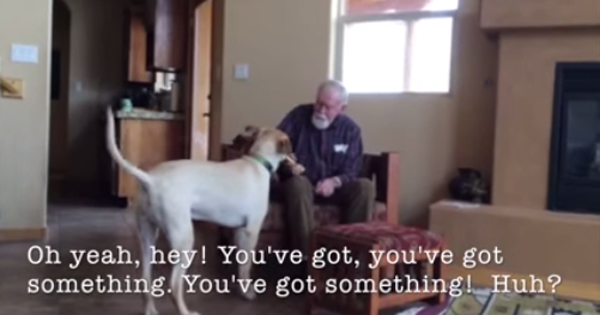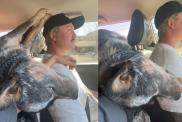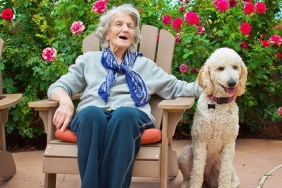Five years ago, Albuquerque, New Mexico resident Charles Sasser was diagnosed with Alzheimer’s Disease, an incurable and degenerative disease that causes memory loss, cognitive impairment, confusion, and the loss of various bodily functions as the disease progresses. The illness and its effects are brutal for the sufferer and heartbreaking to the friends and family of the person diagnosed. Roughly 5.2 million people in the U.S. currently live with Alzheimer’s, and more than 500,000 lose their lives to the disease every year.
Sasser, who is in the advanced stage of the disease, has, for the most part, lost his ability to speak, according to his daughter, Lisa Abeyta. Often, Sasser struggles to find the words he needs to express how he’s feeling or what he needs.
But that all changes when Abeyta’s mostly non-verbal dad is around the family dogs. In a touching video posted to Abeyta’s YouTube account four days ago, Sasser lights up as Abeyta’s dog, Roscoe, presents him with a chew toy. Then, incredibly, Sasser starts talking, having a sweet conversation with his daughter’s dog.
“Oh yeah, hey! You’ve got, you’ve got something! You’ve got something, huh?” Sasser says excitedly to Roscoe, who responds with a friendly wag of the tail, almost urging Sasser to continue. “Yeah, well, that…that’s too bad, there. That’s all. That’s all I’ve got.”
In perhaps the most poignant part of the video, Sasser turns to Roscoe, saying, “Why don’t I take care. I’ll take you. And you take me,” capturing in a few simple phrases the special relationship he shares with his four-legged family members.
Abeyta says her father still has a close relationship with his own dogs, Molly and Cassy, who help Sasser through even the most difficult days of his illness.
“My parents have two dogs in their home, one of which, Molly, is my father’s constant companion,” Abeyta writes on her blog. “More than once, I’ve watched him coo and talk to Molly even as his ability to form sentences and find the words he needs to communicate has deteriorated.”
Abeyta tells ABC News that during her father’s hour-long exchange with Roscoe, she was continually surprised by her dad’s “clarity and the ability to get out a complete sentence, not just a word here and there.”
Experts are not surprised that dogs like Roscoe have such an impact on the lives of those who have Alzheimer’s or dementia. According to the Alzheimer’s Association, pets can provide emotional support and much-needed socialization for sufferers of the crippling disease. In fact, pet therapy is often recommended for Alzheimer’s and dementia patients.
“If pet ownership was a medication, it would be patented tomorrow,” the Mayo Clinic Medical School’s Dr. Edward Creagan quips.
As for the now famous video of Charles Sasser and his buddy Roscoe, Abeyta says she is amazed by the reactions she has received. The video, which Abeyta originally posted to YouTube for her mother, has been viewed more than 3.5 million times.
“I had no idea the video would touch so many people or be shared so many times,” Abeyta writes. “The comments and emails — for the most part — have been a wonderfully moving procession of individuals sharing their own journey through Alzheimers or dementia.”
She says that many people have reached out to her with their own stories of how pets have helped them through difficult times, including illnesses and family tragedies.
“It is a cruel disease, and the kind words of others who have faced similar experiences has left me feeling not quite so alone in it all,” Abeyta adds.
Abeyta tells the Telegraph that she hopes the video will inspire dog owners to visit patients in Alzheimer’s care facilities with their furry friends.
Sources: LisaAbeyta.com, ABC News, YouTube, Telegraph










